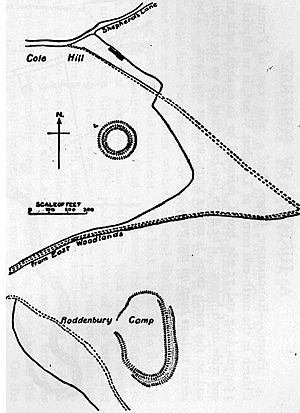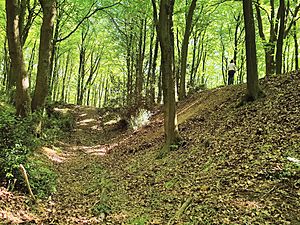Roddenbury Hillfort facts for kids
Quick facts for kids Roddenbury Hillfort |
|
|---|---|

Plan of the site
|
|
| Location | Selwood, Somerset, England. |
| Area | 0.84 hectares (2.1 acres) |
| Built | Iron Age |
| Reference no. | 24020 |
| Lua error in Module:Location_map at line 420: attempt to index field 'wikibase' (a nil value). | |
Roddenbury Hillfort is an ancient fort from the Iron Age in Selwood, Somerset, England. It's a special historical site, protected as a Scheduled Ancient Monument. It's also on a list of heritage sites that need care, called the Heritage at Risk Register. This old fort is found near where Hales Castle was built much later.
This ancient fort covers about 0.84 hectares (2.1 acres). It is a univallate hillfort, meaning it has one main set of protective walls and ditches. In some parts, the protective bank has been destroyed over time. In other areas, it still stands up to 1.6 meters (5.2 feet) high. Below this bank, there is a ditch that is about 1.8 meters (5.9 feet) deep.
What Are Hillforts?
Hillforts are large, ancient forts built on hills. They were mostly built during the Late Bronze Age and Early Iron Age. This was around the start of the first thousand years BC. People have long wondered why these forts were built in Britain. They also debate what their main purpose was.
Why Were Hillforts Built?
Some experts believe hillforts were military sites. They might have been built to defend against invaders from other parts of Europe. Others think they were built by the invaders themselves. Another idea is that they were a military response to problems within society. This could have been caused by more people living in the area. More people meant more pressure on farming and food.
Since the 1960s, a popular idea has been about iron. When people started using more iron, it changed society in Britain. Iron ore was found in different places than tin and copper. These metals were needed to make bronze. Because of this, old trading routes changed. The powerful people of the past lost their wealth and status. New groups of people gained power instead.
Archaeologist Barry Cunliffe thinks that a growing population was also important. He explained that forts offered protection for communities. This was especially true when population stress led to open fighting. But he doesn't believe they were built only because there was a war. He sees them as places for defense during times of tension. Some forts were attacked and destroyed, but this wasn't the only reason they were built.


